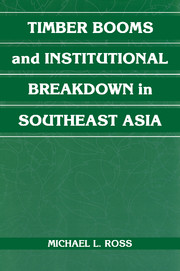Book contents
- Frontmatter
- Contents
- Illustrations
- Tables
- Preface
- 1 Introduction: Three Puzzles
- 2 The Problem of Resource Booms
- 3 Explaining Institutional Breakdown
- 4 The Philippines: The Legal Slaughter of the Forests
- 5 Sabah, Malaysia: A New State of Affairs
- 6 Sarawak, Malaysia: An Almost Uncontrollable Instinct
- 7 Indonesia: Putting the Forests to “Better Use”
- 8 Conclusion: Rent Seeking and Rent Seizing
- Appendix: Chronologies of Events
- References
- Index
4 - The Philippines: The Legal Slaughter of the Forests
Published online by Cambridge University Press: 30 July 2009
- Frontmatter
- Contents
- Illustrations
- Tables
- Preface
- 1 Introduction: Three Puzzles
- 2 The Problem of Resource Booms
- 3 Explaining Institutional Breakdown
- 4 The Philippines: The Legal Slaughter of the Forests
- 5 Sabah, Malaysia: A New State of Affairs
- 6 Sarawak, Malaysia: An Almost Uncontrollable Instinct
- 7 Indonesia: Putting the Forests to “Better Use”
- 8 Conclusion: Rent Seeking and Rent Seizing
- Appendix: Chronologies of Events
- References
- Index
Summary
The combined effects of kaiñgin [swidden] farming and the “legal” slaughter of the forest include widespread erosion and a reported deterioration in climatic conditions. Every recent study of forestry has stressed this alarming and irresponsible destruction … The public should be shocked into a realization of the consequences of continued suicidal forest destruction.
(World Bank 1962: 16)In 1951, the Philippines became the world's leading exporter of hardwood logs. Though heavily damaged by the war, the Philippine forest sector was in an admirable position. Almost half the nation was forested, and the logging industry used some of the most advanced harvesting practices in the tropics. Most important, the timber industry was governed by a forestry bureau with a well-trained staff, a considerable degree of political independence, a policy of promoting sustained-yield forestry, and a reputation for avoiding the corruption and patronage that plagued many other government agencies. Yet, by the 1960s, the forestry bureau had lost its political independence; its policy of sustained-yield logging was all but abandoned; and the nation's forests were on their way to being badly overlogged.
This chapter shows how the timber windfall of the early 1950s led to rent seizing, which in turn led to the deterioration of the institutions and policies that protected the forests.
- Type
- Chapter
- Information
- Publisher: Cambridge University PressPrint publication year: 2001



